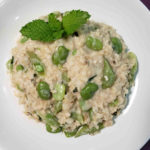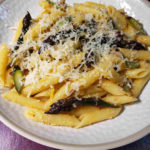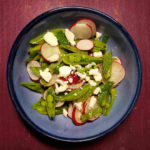Most of us are familiar with coleslaw. The name coleslaw comes from the Dutch word koolsla, meaning cabbage salad. In the US, we expect coleslaw to be shredded cabbage with a small amount of shredded carrot, and then dressed with either a creamy mayonnaise based dressing or a tangy vinaigrette. We expect it to be served at family cookouts or as a side with pulled pork barbeque. Certainly, those are great options, but if you can free yourself from the cole, you can slaw so much more than cabbage. And you can use versatile dressing options, to make some great crispy salad options. The main rule is to keep it simple.
What can you slaw?
Of course, there’s cabbage and carrots. But any crisp fruit or vegetable that can be eaten raw can be slawed: turnips, radishes, beets, fennel, and apples, for example. Sturdy greens such as collards and kale can be julienned for slaws. Kohlrabi is a natural slaw option with 3 different flavors and textures existing between the main bulb, the leaves, and the leaf stems.
How do you slaw?
There’s no reason that you can’t slaw everything with a chef’s knife and a cutting board. It’s my preferred method with cabbage. Slice the cabbage into quarters, cut the core out of one quarter, slice as thinly as possible, then cross slice a couple times to break up the longest pieces. It’s also my preferred method with sturdy greens. I usually roll up a bunch of greens into a cigar shape, and then slice thinly down the “tube.” If the leaves aren’t rollable, I’ll stack them up, and then thinly slice of shreds from the stack. For solid produce like root vegetables, you certainly have the option of using a chef’s knife, first cutting thin slices, and then stacking the slices to cut toothpick sized slivers. It’s great knife skill practice, but it does take time. Using a gadget such as a mandolin or a food processor may be the most efficient choice.
OK, how do you dress your slaw?
Again, keep it simple. There’s no reason that you can’t dress your fresh slaw with the prepared bottle of balsamic vinaigrette in your fridge. But I’ll provide some simple recipe options:
Basic Mayonnaise Based Slaw Dressing:
- ½ cup mayonnaise
- 2 Tbsp apple cider vinegar
- 2 Tbsp honey
- 1 Tbsp Dijon mustard
- 1 tsp celery seeds
- Salt and freshly ground black pepper to taste
Basic Vinaigrette Slaw Dressing:
- ¼ cup apple cider vinegar
- ¼ cup olive oil
- 1 Tbsp honey
- 1 Tbsp Dijon mustard
- 1 tsp celery seeds
- Salt and freshly ground black pepper to taste
Notes:
- The sweet/sour ratio is highly personable. Feel free to omit the honey or change the ratio of vinegar to honey. Actually, all of the flavor ratios are personable. Always feel free to adjust ratios to your tastes!
- I use a raw apple cider vinegar for the probiotics, but you can substitute other mild vinegars. For a different flavor profile, fresh squeezed citrus juice may replace the vinegar.
- Similarly, I feel there’s more nutrition (and flavor) in honey than processed white sugar, but you could use sugar instead of honey.
- Celery seeds are a distinctive component in traditional coleslaw dressing. They really work well here. But you may not have them in your pantry. You can swap something else for the celery seeds, understanding that the flavor profile will also change. A few options that I like are ground coriander, cumin and poppy seeds.
- The vinaigrette option is best if it is fully emulsified. To make it really simple, put all the ingredients in a wide mouthed mason jar, and then use an immersion blender to quickly and completely emulsify the oil and vinegar.
Now, get creative:
Serving with a Mexican theme? Replace the vinegar with lime juice and mix chopped cilantro into the slaw.
Serving with a Chinese theme? Replace the apple cider vinegar with Chinese black vinegar or with rice wine vinegar. Pull the Dijon mustard and celery seeds. Add in a teaspoon of minced ginger, a teaspoon of soy sauce and a teaspoon of toasted sesame seed oil.
Another Asian influenced idea: Drop the Dijon and celery seeds and add a tablespoon of sriracha, a teaspoon of fish sauce and a teaspoon of toasted sesame seed oil. Bonus if you also chop up some kimchi to add to the slaw.
Mediterranean Lemon herb: Zest a couple of lemons and juice them. Replace the vinegar with lemon juice and add lemon zest and chopped parsley, cilantro, and/or mint to the slaw.






